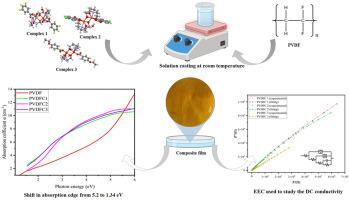通过浸透双核铜(II)配合物在PVDF复合材料中的带隙调谐和电增强:形态学、光学和电化学的见解
IF 4.2
3区 材料科学
Q2 MATERIALS SCIENCE, MULTIDISCIPLINARY
引用次数: 0
摘要
聚合物基介电材料由于其更大的灵活性、可靠性和高击穿强度,处于下一代储能和光电子技术的前沿。在这项工作中,我们设计了先进的聚偏氟乙烯(PVDF)聚合物基复合材料,通过浸渍双核铜(II)配合物:[Cu2(3,5- diflb)2(H2tea)2](H2O) (1), [Cu2(4-ClB)2(H2tea)2](H2O) 2(2)和[Cu2(4-ETHB)2(H2tea)2](H2O)2(3),从结构上调节分离复合材料的结构,光学和电化学性能。利用FT-IR, PXRD, AFM和FE-SEM进行综合表征,揭示了强聚合物复合物相互作用,抑制结晶度,增加表面粗糙度,所有这些都表明异质结处的界面动力学增强。形态学研究证实了Cu (II)配合物在基体中的均匀分布,而能谱图显示了优异的金属离子分布。通过漫反射光谱进行的光学调谐显示了红移吸收和显著的带隙缩小。最值得注意的是,电化学阻抗谱证明了电学性能的显著提高,这归功于改进的电荷传输途径和减少的极化。这些多功能复合材料为未来智能能源和电子应用量身定制的高性能铜集成聚合物系统提供了一个引人注目的平台。此外,我们还进行了密度泛函理论(DFT)前沿分子轨道(FMO)分析和分子动力学(MD)模拟,以更深入地了解复合材料的电子结构和动态稳定性。本文章由计算机程序翻译,如有差异,请以英文原文为准。

Band gap tuning and electrical enhancement in PVDF composites via impregnation of binuclear copper (II) complexes: Morphological, optical, and electrochemical insights
Polymer-based dielectric materials are at the forefront of next-generation energy storage and optoelectronic technologies, owing to their greater flexibility, reliability, and high breakdown strength. In this work, we engineered advanced polyvinylidene fluoride (PVDF) polymer -based composites by impregnating dinuclear copper(II) complexes: [Cu2(3,5-DIFLB)2(H2tea)2](H2O) (1), [Cu2(4-ClB)2(H2tea)2](H2O) (2), and [Cu2(4-ETHB)2(H2tea)2](H2O)2 (3), structurally reported by our group to strategically modulate the structural, optical, and electrochemical properties of isolated composites. Comprehensive characterization using FT-IR, PXRD, AFM, and FE-SEM unveils strong polymer-complex interactions, suppressed crystallinity, and increased surface roughness, all pointing to enhanced interfacial dynamics at heterojunctions. Morphological studies confirmed uniform dispersion of Cu (II) complexes in the matrix, while EDS mapping highlights excellent metal ion distribution. Optical tuning via diffuse reflectance spectroscopy reveals red-shifted absorption and notable band gap narrowing. Most notably, electrochemical impedance spectroscopy demonstrated a substantial boost in electrical performance, attributed to improved charge transport pathways and reduced polarization. These multifunctional composites present a compelling platform for high-performance, copper-integrated polymer systems tailored for future smart energy and electronic applications. In addition, we have performed density functional theory (DFT) frontier molecular orbital (FMO) analysis and molecular dynamics (MD) simulations to gain deeper insights into the electronic structure and dynamic stability of the composites.
求助全文
通过发布文献求助,成功后即可免费获取论文全文。
去求助
来源期刊

Optical Materials
工程技术-材料科学:综合
CiteScore
6.60
自引率
12.80%
发文量
1265
审稿时长
38 days
期刊介绍:
Optical Materials has an open access mirror journal Optical Materials: X, sharing the same aims and scope, editorial team, submission system and rigorous peer review.
The purpose of Optical Materials is to provide a means of communication and technology transfer between researchers who are interested in materials for potential device applications. The journal publishes original papers and review articles on the design, synthesis, characterisation and applications of optical materials.
OPTICAL MATERIALS focuses on:
• Optical Properties of Material Systems;
• The Materials Aspects of Optical Phenomena;
• The Materials Aspects of Devices and Applications.
Authors can submit separate research elements describing their data to Data in Brief and methods to Methods X.
 求助内容:
求助内容: 应助结果提醒方式:
应助结果提醒方式:


